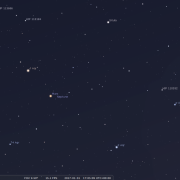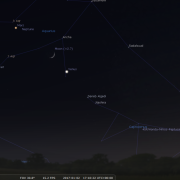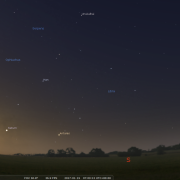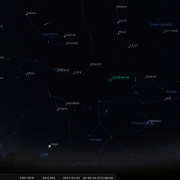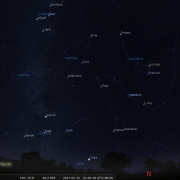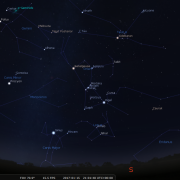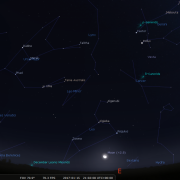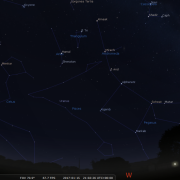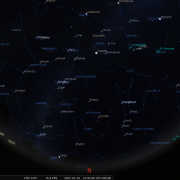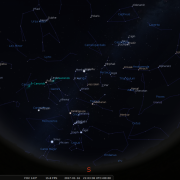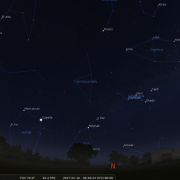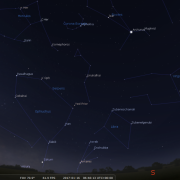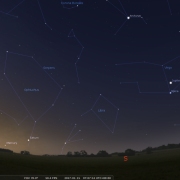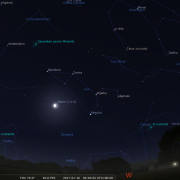In this month's Sky Notes:
Planetary Skylights
 The Planet Venus dominates the evening twilight sky, a brilliant object across in the South-West. Through a telescope little can be discerned of the surface, however being an inferior planet (one that orbit’s inside earth’s orbit) Venus does exhibit a phase which is currently a shrinking half phase in nature. Venus reaches greatest eastern elongation on the 12th, the same evening it lies closest to Neptune. The pair should fit in the same telescopic view at low power, so if you miss the Mars conjunction (see below) you have another bite at Neptune. Over the course of the 1st and 2nd a slender crescent moon also lies in the vicinity making for a pleasing conjunction. The same occurs again on the last evening of January.
The Planet Venus dominates the evening twilight sky, a brilliant object across in the South-West. Through a telescope little can be discerned of the surface, however being an inferior planet (one that orbit’s inside earth’s orbit) Venus does exhibit a phase which is currently a shrinking half phase in nature. Venus reaches greatest eastern elongation on the 12th, the same evening it lies closest to Neptune. The pair should fit in the same telescopic view at low power, so if you miss the Mars conjunction (see below) you have another bite at Neptune. Over the course of the 1st and 2nd a slender crescent moon also lies in the vicinity making for a pleasing conjunction. The same occurs again on the last evening of January.
 Mars resides upper left of Venus and is reasonably conspicuous to the naked eye, the ruddy hue a giveaway. Through a telescope Mars appears as a very small gibbous ball with little, if any, detail visible. Mars does however serve very nicely as a guide to the location of a far more distant planet, Neptune, which resides very close to the red planet in the sky during the last few days of 2016 and the start of 2017.
Mars resides upper left of Venus and is reasonably conspicuous to the naked eye, the ruddy hue a giveaway. Through a telescope Mars appears as a very small gibbous ball with little, if any, detail visible. Mars does however serve very nicely as a guide to the location of a far more distant planet, Neptune, which resides very close to the red planet in the sky during the last few days of 2016 and the start of 2017.
 On Jan 1stNeptune and Mars are separated by just 18 arc minutes, easily framed in the same low/medium eyepiece field through most telescopes. Neptune will have a tiny blue grey disk. The moon joins the party on the 3rd.
On Jan 1stNeptune and Mars are separated by just 18 arc minutes, easily framed in the same low/medium eyepiece field through most telescopes. Neptune will have a tiny blue grey disk. The moon joins the party on the 3rd.
 In the dawn sky Jupiter reigns supreme. Rising in the early morning hours, it is best placed an hour before sunrise, almost due south. Jupiter resides above the bright star Spica in Virgo, the pair joined by a waning crescent moon on the 19th forming a perfect line.
In the dawn sky Jupiter reigns supreme. Rising in the early morning hours, it is best placed an hour before sunrise, almost due south. Jupiter resides above the bright star Spica in Virgo, the pair joined by a waning crescent moon on the 19th forming a perfect line.
 Mercury has a foray into the dawn sky during January, although it never strays far from the east horizon. It will be more conspicuous mid month onwards; 14th-23rd when it should be visible to the naked eye at mag - 0.5.
Mercury has a foray into the dawn sky during January, although it never strays far from the east horizon. It will be more conspicuous mid month onwards; 14th-23rd when it should be visible to the naked eye at mag - 0.5.
 A ‘star’ of almost similar brightness residing to the upper right of Mercury is the planet Saturn, which is gradually moving up and out of the Sun’s glare. Although still a little close to the horizon, if you get chance, do try to have a look at Saturn through a telescope, it is worth the early rise effort’ View approximately 35mins before sunrise to catch both Saturn with Mercury. A very slim crescent moon passes above on the 25/26th.
A ‘star’ of almost similar brightness residing to the upper right of Mercury is the planet Saturn, which is gradually moving up and out of the Sun’s glare. Although still a little close to the horizon, if you get chance, do try to have a look at Saturn through a telescope, it is worth the early rise effort’ View approximately 35mins before sunrise to catch both Saturn with Mercury. A very slim crescent moon passes above on the 25/26th.
Meteor Showers

The year starts with one of the more prolific meteor showers, the Quadrantids, active between Jan 1- 6th. The short lived shower peak normally falls over the night of 3rd/4th, with best rates witnessed in the small hours; 02:00-04:00h.
Peak zenith hourly rates are in the 80-100 per hour bracket, but actual observed rates by an individual will be around the 20–30 mark. Quadrantids are often, fairly swift, producing occasional yellow-green fireballs.
Quadrantids appear to radiate from the now defunct constellation of Quadrans Muralis, which was removed from sky charts in 1922, but used to lie at the junction between Hercules, Bootes and Ursa Major. This position in the sky is located low to the N at the time of the peak, so do not concentrate on this aspect if viewing.
Comet 45P
Comet 45P Honda-Mrkos-Pajdusukova (45P HMP) may reach naked eye visibility during the first week of the New Year. As usual northern hemisphere observers are at a disadvantage with the comet low in the twilight sky.
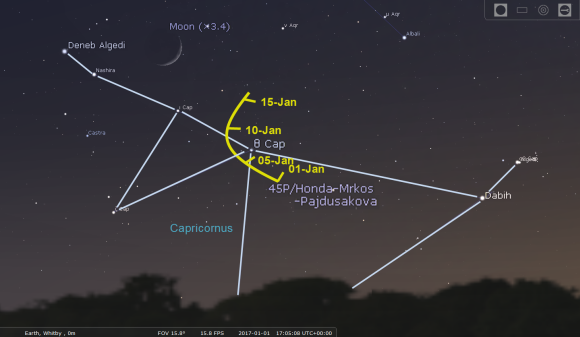
Finder Chart for Comet 45P Honda-Mrkos-Pajdusukova, 01-15-Jan-2017
The best chance of spotting the comet is during the first few days of January. Look over to the SW where Venus is totally dominant. Mars lies approx 5 degrees upper left of Venus. Now imagine a line drawn from Mars thru’ Venus and extended just under twice that distance to the lower right.
The comet resides in this part of the sky (actually in Capricornus) View around 17:00-17:30h using binoculars. Hopefully you will come across a fuzzy blob with perhaps a tail. The comet is predicted to reach +6.5 magnitude; borderline naked eye, but we all know how fickle comets are, so you never know.
January 2017 Sky Charts
Click each image to see a full-size Sky Chart:
Additional Image Credits:
- Planets and Comets where not otherwise mentioned: NASA
- Sky Charts: Stellarium Software
- Log in to post comments

